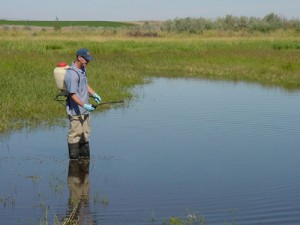21
Aug
Bill Introduced to Restrict the Pesticide Methoprene in Estuaries in New York County
(Beyond Pesticides, August 21, 2013) Suffolk County, New York, Legislator Jay Schneiderman (I-Montauk) introduced a bill on July 30, 2013 to establish strict guidelines for the use of methoprene within estuaries in Suffolk County. Methoprene, an insect growth regulator, is commonly used in mosquito control programs, but is highly toxic to estuarine invertebrates, including crabs and lobsters, which are the backbone of the fishing industry along the East coast. This bill  follows similar legislation already passed in Connecticut and Rhode Island to help protect lobster populations.
follows similar legislation already passed in Connecticut and Rhode Island to help protect lobster populations.
The lobster population in the Long Island Sound has decreased dramatically over the last decade, corresponding with the introduction of pesticides such as methoprene in mosquito control programs. Methoprene is an insect growth regulator that prevents development to the adult reproductive stages so that insects die in arrested immaturity. It is an insecticide that is acutely toxic to estuarine invertebrates, including valuable food and commercial species like crabs and lobsters. The effect of mosquito pesticides on marine life, especially lobsters, has come under scrutiny in recent years as mosquito spray programs in various states escalated efforts to suppress West Nile virus (WNv). Other mosquito-killing chemicals suspected of causing damage to aquatic life include many pyrethroid and organophosphate insecticides, which are known to be toxic to many aquatic species, including crustaceans.
Mr. Schneiderman’s bill (IR 1692-13) stipulates that methoprene could only be applied in estuaries when one or more disease threats have been identified in local mosquito populations, or two or more bacterial insecticide treatments, such as Bacillus Thuringiensis Israelensis (BTI), have been unsuccessful in limiting mosquito population numbers.
“The county should be doing everything it can to limit the unnecessary introduction of toxins into our environment. Methoprene poses the possibility of causing damage to key species that our recreational and commercial fishermen depend on. There are alternatives to methoprene that have not been shown to be harmful to our crabs and lobsters,” said Mr. Schneiderman.
Declines in the Long Island Sound’s lobster population have been alarmingly common for the past 15 years, devastating fishermen and the local economy that depends on them. Lobster populations fell from 3.7 million pounds in 1998 to 142,000 pounds in recent years, and pesticides have long been suspected in killing off lobsters. In 2003, researchers at the University of Connecticut found that methoprene was deadly to lobsters at concentrations of only 33 parts per billion, and in 2012 a Connecticut state Department of Energy and Environmental Protection study detected residues of mosquito control pesticides: malathion, methoprene, and resmethrin in lobsters pulled from Long Island Sound. Lobstermen have long challenged the use of methoprene and other mosquito control pesticides, and have been vocal about the need for alternative methods for WNv control, including switching to the use of the less toxic Bacillus Thuringiensis (Bt).
Connecticut recently passed legislation banning methoprene. This bill was in direct response to decreased lobster population in the Long Island Sound. The Connecticut law prohibits the introduction of methoprene into any storm drain or conveyance of water in the coastal boundary zone in an effort to prevent these chemicals from being introduced into the Long Island Sound. Similarly, cities and towns throughout Rhode Island have also stopped using methoprene in storm drains and instead use Bacillus Sphaericus – a naturally occurring bacterium related to Bt that kills mosquitoes without affecting lobsters or other non-target organisms. Maine is the only East Coast fishery where methoprene has been banned for an extended period. As a result, the lobster population is at acceptable, sustainable levels.
Mr. Schneiderman first introduced similar controversial restrictions in 2007, but they were not adopted by the legislature after opposition from Suffolk County Vector Control officials, even though New York City banned the use of methoprene in 2001 in areas where it would spread into wetlands and groundwater. Mr. Schneiderman hopes his bill will fare better this time in light of the new studies and legislative action in Connecticut, Rhode Island and other areas. The new legislation in Connecticut and Rhode Island are being met with resistance from some who believe that these policies will lead to an increased risk of West Nile Virus (WNv) and Eastern Equine Encephalitis (EEE). However, these new laws explicitly allow the use of the chemicals if a mosquito-borne disease is found or suspected.
Mosquito spraying programs have been legally challenged in Suffolk County. A 2004 lawsuit was filed by Peconic Baykeeper, part of the Riverkeeper environmental action network, against Suffolk county’s mosquito spray program to reform mosquito control practices in the county. The suit charged that Suffolk County violated the Clean Water Act (CWA) by filling wetlands with dredge spoil, discharging pollutants conveyed through mosquito ditches, and discharging restricted pesticides into surface waters. For four years prior to the legal action under New York State environmental law, Peconic Baykeeper’s advocacy helped persuade Suffolk County to adopt methods of mosquito control that are health-based, scientifically-justified, and not destructive to the environment.
There are safer and effective options for dealing with mosquitoes and insect-borne diseases. The ideal mosquito management strategy comes from an integrated approach emphasizing education, aggressive removal of standing water sources, larval control, monitoring, and surveillance for both mosquito-borne illness and pesticide-related illness. Beyond Pesticides advises communities to adopt a preventive, health-based mosquito management plan, and has several resource publications on the issue, including the Public Health Mosquito Management Strategy: For Decision Makers and Communities. Visit Beyond Pesticides’ West Nile Virus/Mosquito Management for more details.
All unattributed positions and opinions in this piece are those of Beyond Pesticides.
Source: News Release: Office of Jay H. Schneiderman, Suffolk County Legislator, Second District










